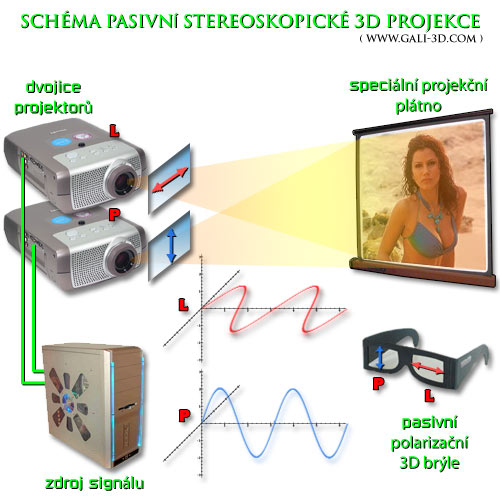The Passive 3D Stereoscopic Technology

Passive 3D stereoscopy
The 3D passive technology is usually connected to the 3D projection system but nowadays 3D passive monitors and television exist as well. The common elements for these devices are 3D glasses based on polarization filters. The glasses contains no active electronic nor batteries, so the whole technology is called passive 3D.
Passive 3D projection
The principle will be demonstrated on passive 3D projection. For the visualization we need ě projectors working in a synchronized way. Form the signal source (in this case DepthQ Media Player) we get two synchronized signals for the left eye and the right eye projectors. Each of the projectors are equipped by a polarization filters forcing the light to wave only in a specific plane.
 Special 3D screen
Special 3D screen
It is necessary to use a special screen surface for 3D passive projection. The two images looks like blended eon the screen but they still preserve their polarization properties so separation is possible. Additional pair of polarization filets place in the glasses can take care about paper image delivery in the left and right eye.
Polarization mask
Passive 3D technology can be used in TV and 3D monitors as well. The TV or monitor have only one visualization unit, so it is necessary to use a bit different approach than for projection. A special layer consisting form polarization filter strips covers the display. Each strip polarizes the light in different plane. The native resolution of the monitor is spread in 2 half images so such monitor operates in 3D mode in half resolution in comparison to 2D mode.
Polarization converter
There exist and additional method for 3D TV and monitors how to generate passive 3D stereoscopic image. This method is derived from active 3D. A special LC panel giving odd and even sequential images different polarization covers the screen area. Such technology does not reduce the original display resolution and can be used with cheap passive glasses. This technology works for projection as well (see Active-passive hybrid system).
Advantages of passive 3D technology
The main advantages of 3D passive technology are cheap paper or plastic glasses. This technology is often used in cinemas and during events targeted on a lot of people.
Overview of 3D stereoscopic technologies:
| technology | color informations | rozlišení obrazu | projection | monitors / tv | num. of viewers | 3D cinema expenses [price / operating costs] |
| Active 3D | full | high | yes (2) | yes (3) | limited (4) | high / high |
| Passive 3D | full | high | yes | yes | high | high / low (5) |
| 3D Polarization Modulator | full | high | yes | no | high | middle / low |
| 3D Auto-Stereoscopic Monitors | full (1) | low | no | yes | low | - |
| 3D Anaglyph | very bad | middle | yes | yes | high | low / low |
(2) - active 3D is not suitable for large 3D cinemas. Active 3D glasses are expensive and servising is also hard job (repairing, changing/recharging bateries).
(3) - active 3D displays (3D TV, computer 3D flat panels) provide the highest 3D quality from all 3D screens.
(4) - number of viewers is limited by expensive 3D glasses and the wireless signal range.
(5) - 3D Modulator is currently the best 3D technology for all modern 3D digital cinemas.

